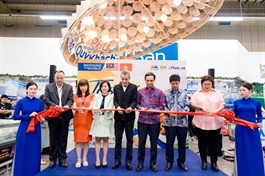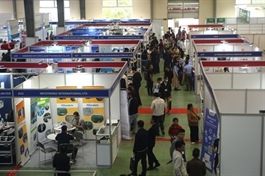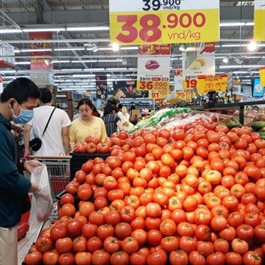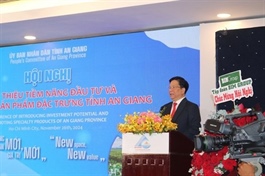Vietnamese firms urged to improve product packaging to conquer the Chinese market
Vietnamese firms urged to improve product packaging to conquer the Chinese market
Việt Nam now exports 14 kinds of farm produce to China; however those are mainly raw goods. To sell agricultural products directly to Chinese consumers, Vietnamese companies are advised to focus on improving product label design and packaging. Lê Thu Lụa, chief representative of Sunwah Group in Hà Nội - a company that has been operating in Việt Nam for 50 years, spoke to Việt Nam News reporter Tố Như about how to improve exports.
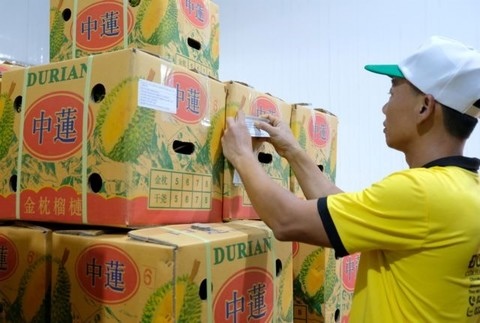
Lê Thu Lụa, chief representative of Sunwah Group in Hà Nội. — VNS Photo |
How do you evaluate Vietnamese agricultural products, compared to those in other countries, including China?
Each product has its own strengths and characteristics. Vietnamese products have their origin and freshness. They are also typical products of the tropical region. In particular, Việt Nam's famous products such as durian, coconut and other fruits are all strong and can be exported fresh to the Chinese market.
Meanwhile, products from other countries, for example from China's Henan Province, are mainly instant, processed ones with various different flavours. This is the regional difference that we can fully take advantage of to promote trade activities between the two sides.
The quality of Vietnamese farm produce has currently improved significantly and has made a good impression in the eyes of international customers. The Chinese market and consumers have given special recognition to the quality of these products.
However, there remains room for Vietnamese firms to improve their agricultural products such as diversifying the products' packaging and label design to suit the criteria and requirements of this important market.
Therefore, in the future, Sunwah Group and partners in China will cooperate with the Ministry of Agriculture and Rural Development and the Agricultural Trade Promotion Centre to provide advice as well as give new directions for agricultural products, especially in processing, manufacturing and packaging to meet the market needs.

Boxes of durian from Lâm Đồng Province's Bảo Lâm District ready for export to China. — VNA/VNS Photo |
What farm products in Việt Nam will Sunwah continue to export to China?
Currently, we are focusing on some products, including coffee, dried fruit products, along with some for herbal medicine. They are Việt Nam's strong agricultural products. We will concentrate on promoting these products in the Chinese market.
A virtual booth selling Vietnamese agricultural products on e-commerce platforms and social networks in China has been launched recently. How do you evaluate this move?
This is a very important channel to promote agricultural trade between Việt Nam and China.
China is a very large importer of Việt Nam's farm produce. It now accounts for a fairly high proportion of Việt Nam's total agricultural import and export turnover. Thus, the launch of the Vietnamese agricultural products on the digital platform in China is a new step in the journey of promoting Vietnamese goods exported through e-commerce to the Chinese market.
Currently, e-commerce holds an extremely large market share in China. The consumption trends of the Chinese are shifting, so when we capture this market share, it will also mark a new turning point in the story of Việt Nam's farm produce exports.
As a bridge connecting Vietnamese farm produce to the Chinese market, what recommendations do you have for Vietnamese businesses to be able to export more products to this market?
When working with businesses, the most important thing I think is that they must improve the products' packaging. The packaging of Vietnamese agricultural products is too simple, which may be acceptable to consumers in Việt Nam and other countries rather than Chinese ones.
However, in the Chinese market, they have very special preferences, so Vietnamese businesses need to improve the product label image, as well as increase cultural recognition with specific images of Việt Nam.
Vietnamese businesses also need to diversify the taste of their products to suit the market. Mostly in the Chinese market, consumer culture and taste will be more inclined towards strong flavours than the tastes of Vietnamese consumers.
In addition, businesses should also engage deeply in e-commerce, improve the corporate governance system to be more professional, as well as have a specialised personnel team instead of just one team in charge of all export markets.
Because the Chinese market is unique, with separate language and cultural barriers, if we do not have a specialised staff dedicated to this market and understand what it needs, it will be very difficult to develop quickly and strongly.
So label product design is considered a weakness of Vietnamese farm produce. What are the necessary criteria for a package that can attract customers?
On product label and packaging, in addition to basic product information, as well as customs requirements for packaging such as having a secondary label, the colour images on the label also need to be improved and diversified with more colours. In addition to expressing the product itself, the packaging should also express the culture and identity of the Vietnamese people.
Chinese products are usually colourfully packaged, with many eye-catching images as Chinese firms have paid effective attention to packaging design. I think that Vietnamese businesses can do the same way. They can team up with designers who can provide unique and specific ideas to make Vietnamese product packaging more eye-catching and easily attract Chinese consumers.
Each product will require a different specific label design. One packaging design cannot be used for all products. It is necessary to understand the nature, competitiveness and advantages of the export products to make attractive packaging.







